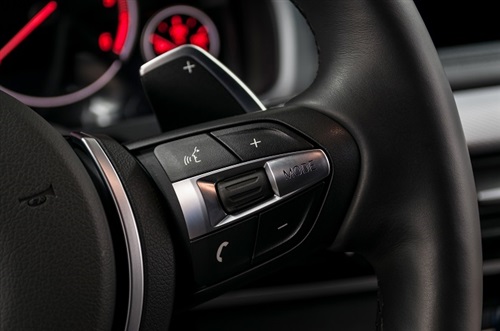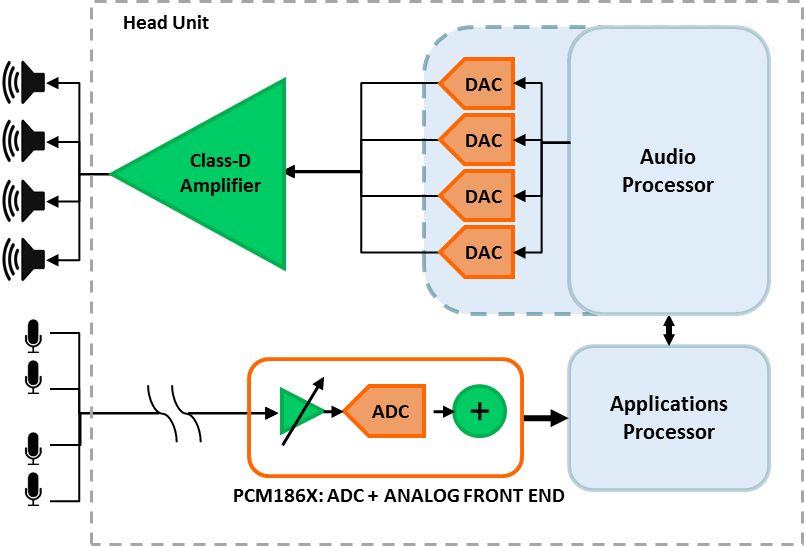SSZTAU4 september 2016 PCM1864-Q1 , PCM1865-Q1

As drivers spend more and more time in their cars, manufacturers are working to make sure that the car cabin is as comfortable as possible. An increasing number of car buyers are looking at noise as one of the decisive factors when selecting a car.
Most car cabin noises like road noise, wind noise and rattling interiors are all undesirable – they are intrusive, reduce the driver’s mental processing power, and can lead to distraction and stress. Thus, car manufacturers market their quietest cars at a premium.
I am sure you can relate when you must take a phone call through a hands-free system while driving. You want to make sure that the person on the line can hear you clearly, and you expect (hope?) that the system rejects noise like air-conditioner airflow, wind noise and road noise inside the cabin. What you need from the car in that case is called noise discrimination.
 Figure 1 Example of a Hands-free
System
Figure 1 Example of a Hands-free
SystemFinally, there is another kind of “noise” (the quotation marks are fully intentional) that is truly in the eye (or should I say ear) of the beholder: engine noise. As engine technology progresses toward maximum fuel efficiency, car engine noise has decreased significantly. Car manufacturers face the car-buyer paradox: drivers want all of the torque and fuel-efficiency of a newer and better engine, but the classic sound of an old gas-guzzler. This is quite a set of challenges and conflicting requirements for manufacturers when designing infotainment systems that must distinguish and suppress some types of noise but allow and perhaps even enhance other types of noise.
Audio Technology for Cabin Comfort
 Figure 2 Typical CSE Simplified Block Diagram
Figure 2 Typical CSE Simplified Block DiagramIn Figure 2, you’ll notice that the sound is captured by a microphone array; in this case, the array comprises four analog electret condenser microphones. Although not shown in Figure 2, the typical electret condenser microphone approximates to a current source when biased. An analog-to-digital converter (ADC) digitizes the audio signal coming from the microphone array, which the applications processor then processes.
In Figure 2, the integrated analog front end is integrated in the ADC to help increase the signal-to-noise ratio (SNR) and achieve higher-quality audio capture. Keep in mind that Figure 2 shows only one of many ways to implement it. For instance, you could use digital I2S microphones, but this alternative may impose higher costs than going with analog microphones and a multichannel ADC.
The applications processor enables the specific functionality of a CSE system depending on the algorithm processed. To reduce unwanted noise, the processor implements active noise cancellation (ANC) algorithms.
The system is designed to reduce the low-frequency noise in the car cabin and operates whenever the car is running, regardless of whether the audio system is on or off. The microphone array captures sound from the drive train and creates a precisely timed reverse-phase audio signal that is sent to the amplifier to power the system speakers and subwoofer without affecting music or conversation volume levels.
To enhance engine sound, the processor implements an engine sound enhancement (ESE) or sound-imposer algorithm, either by playing a pre-recorded engine sound through the stereo system determined by engine load and RPM, or having the microphone array capture sound signals from the drive train, which the processor amplifies and tunes to give drivers a better feel for the engine.
To effectively implement a high-performance hands-free system, the processor implements a microphone beamforming algorithm (MBF). Imagine a beam from the microphone to the driver’s face. The system only “hears” sound present within this beam and rejects sound coming from other directions. The individual microphones in the microphone array are separated by a very specific distance dictated by (among other things) the system sampling frequency. This distance affects the time it takes the sound to reach each a specific microphone, providing the system with enough information about the direction and distance of the sound source and rejecting any sound outside this virtual beam.
The highly processed output signal from the applications processor is mixed in the audio processor with user-specified audio signal sources, such as music from an external source or a phone conversation via Bluetooth®. This mixed signal, which may include every signal from a user-selected source (ANC and ESE in some cases) does not interfere with music or conversation levels.
The amplifier drives the system speakers and subwoofer inside the cabin.
Audio ADC Selection: Weighing the Pros and Cons
The ideal audio ADC needs to:
- Be multichannel to accommodate multiple microphones from the microphone array.
- Have an excellent SNR ratio and dynamic range to clearly capture audio signals and effectively amplify or reject the signal depending on the end application.
- Accurately synchronize not only the sampling from all microphones effectively but also effectively synchronize the high-frequency signals within the converter itself.
ADCs like the PCM1864-Q1 and PCM1865-Q1 enable high-performance, low-cost and small CSE systems. The PCM1864-Q1 and PCM1865-Q1 integrate 4 x 2VRMS analog inputs and an analog front end with clip detect to maximize SNR ratios for high-performance CSE systems, while reducing size and component count.
Have you designed a CSE system? If so, what specifications were most important to you? Log in and leave a comment below.
Additional Resources
- Read about other automotive audio systems in my “Behind the Wheel” blog posts:
- “How does the eCall system work?”
- “The head unit: understanding car audio amplifier system demands – part 1.”
- “Instrument clusters: moving beyond chimes and dings.”
- See ti.com/audio for audio subsystem diagrams, device recommendations and suggested design considerations.